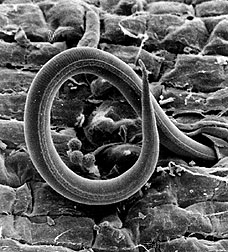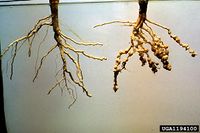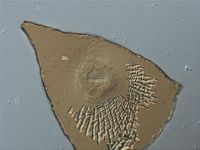Meloidogyne incognita
| Literature database |
|---|
| 1851 articles sorted by: |
| • year (descending) |
| • research topics |
| • countries/regions |
| • host plants |
| • list of antagonists |

Source: Wikimedia Commons
Meloidogyne incognita (Kofoid & White, 1919) - (southern root-knot nematode)
The species is a wide-spread and economically very important nematode in warmer regions and glasshouses. It is perhaps the most common root-knot nematode and infests many types of plants and crops. These include vegetables like tomato, green pepper, cucumber and egg-plant, but also soybean, cotton, cowpea and potato, to name a few. Yield losses above 50% have been reported from various crops. Management options are limited and nematicides are often uneconomical. However, resistant cultivars are available for some crops. At the optimum temperature of 30°C, the development time from J2 to egg-laying female lasts about 2-3 weeks, but can be much longer at lower temperatures.
M. incognita is externally very similar to other species of Meloidogyne and can be identified either through PCR analysis or by the cuticular markings in the perineal area of the mature female. This pattern shows a high squared dorsal arch, but no wavy striae or lateral field. The J2 juveniles are about 400 µm long. For a summary of the biology see the genus Meloidogyne.
| Vernacular names | |
|---|---|
| • Deutsch: | südliches Wurzelgallenälchen |
| • English: | southern root-knot nematode |
| • Français: | anguillule à noeud de la patate |
Synonyms
Meloidogyne acrita
Meloidogyne kirjanovae
- Symptoms of damage by Meloidogyne incognita (IPM Images and PaDIL - click to enlarge)





